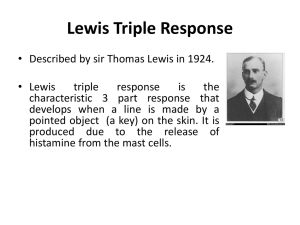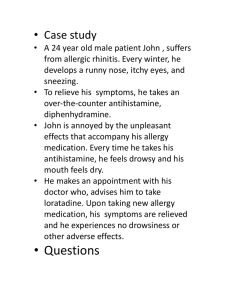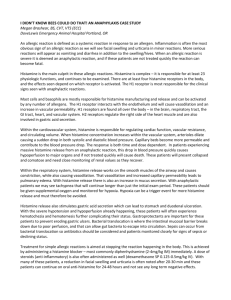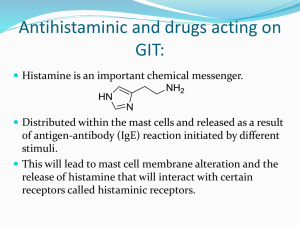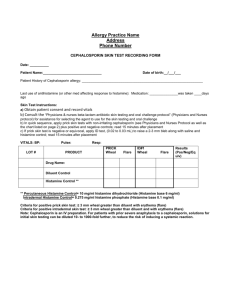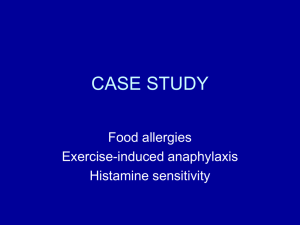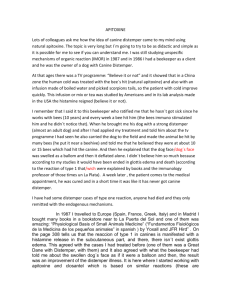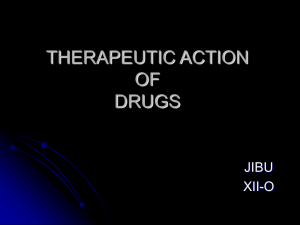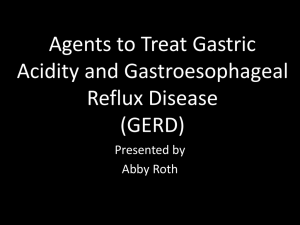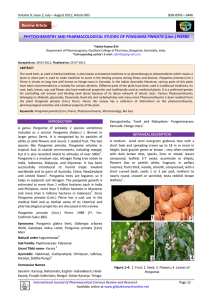Antihistaminic and Antispasmodic Potential of Pongamia
advertisement
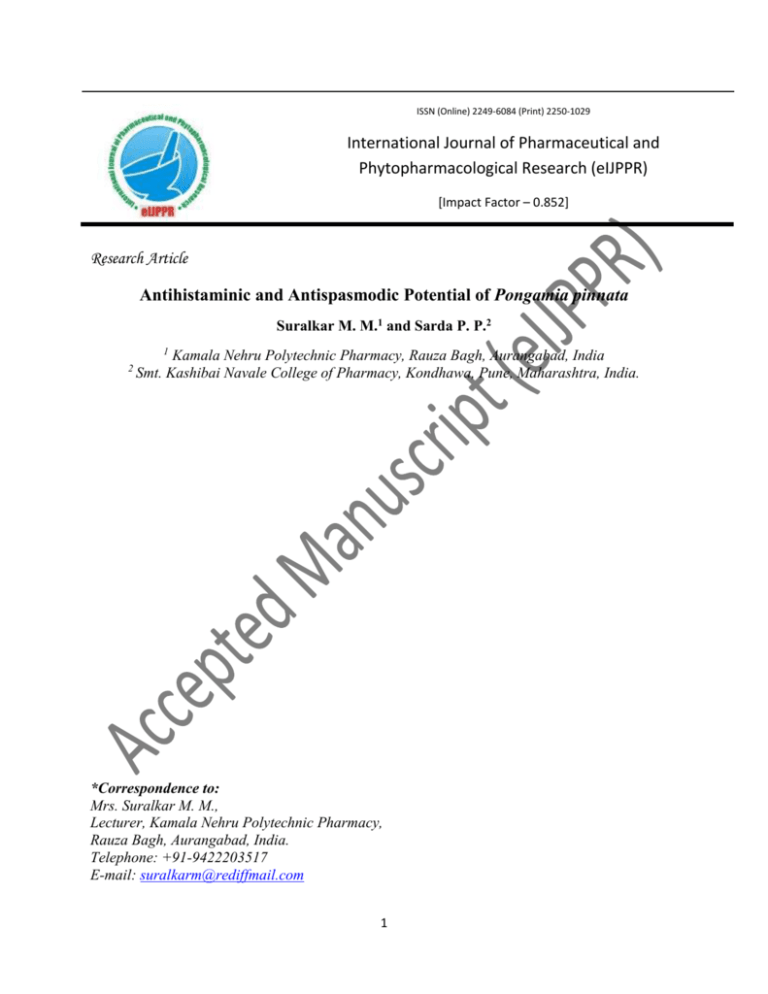
ISSN (Online) 2249-6084 (Print) 2250-1029 International Journal of Pharmaceutical and Phytopharmacological Research (eIJPPR) [Impact Factor – 0.852] Research Article Journal Homepage: www.eijppr.com Antihistaminic and Antispasmodic Potential of Pongamia pinnata Suralkar M. M.1 and Sarda P. P.2 1 2 Kamala Nehru Polytechnic Pharmacy, Rauza Bagh, Aurangabad, India Smt. Kashibai Navale College of Pharmacy, Kondhawa, Pune, Maharashtra, India. *Correspondence to: Mrs. Suralkar M. M., Lecturer, Kamala Nehru Polytechnic Pharmacy, Rauza Bagh, Aurangabad, India. Telephone: +91-9422203517 E-mail: suralkarm@rediffmail.com 1 ABSTRACT The present study was undertaken to evaluate antihistaminic and anti-spasmodic potential of Pongamia pinnata (L) (PP) seeds by using isolated goat tracheal chain and chicken ileum preparation. In isolated goat tracheal chain preparation and in chicken ileum preparation, dose response curve of histamine in absence and in presence of ethanolic extract of PP was plotted. PP showed significant decrease in contraction induced by histamine (30µg/ml) in isolated goat tracheal chain and chicken ileum preparation respectively. These results suggest the antihistaminic and antispasmodic potential of ethanolic extract of Pongamia pinnata seeds (PP). Key words: Pongamia pinnata, Anti-histaminic, Anti-spasmodic, Histamine. 2 1. INTRODUCTION Herbal medicines are being increasingly utilized to treat a wide variety of diseases, though the knowledge about their mode of action is relatively insufficient. Interest regarding the pharmacological evaluation of various plants used in traditional system of medicine is relatively increasing1. The use of traditional medicine is expanding to newer horizons and plants still remain as the novel source of structurally important compounds that lead to the development of innovative drugs. Naturally occurring compounds from plants are still used in pharmaceutical preparations in pure or extracted forms 2. The Pongamia pinnata (L) Pierre belonging to family ‘Papilionaceae’ is popularly known as Karanj. It is medium sized glabrous tree, found the in India and further distributed eastwards mainly in the South Eastern Asia and Australia. Traditionally, the Pongamia pinnata (L) Pierre seeds are being used to treat inflammation, cough, whooping cough and allergic disorders such as asthma, bronchitis3. The seeds of Pongamia pinnata (L) Pierre have been reported for antioxidant4, antiinflammatory5, antibacterial6, antifungal7, anthelminthic activity8. Thus taking into the consideration the traditional claims and reported pharmacological activities of Pongamia pinnata (L) Pierre the present study was undertaken to evaluate anti-histaminic and antispasmodic potential of ethanolic extract of Pongamia pinnata seeds (PP) which may further contribute in allergic disorders. 2. MATERIALS AND METHODS 2.1 Procurement of Plant The seeds of Pongamia pinnata(L) Pierre were collected from the local area in Kolhapur, Maharashtra and were authenticated from Agharkar Research Institute, Pune, India (Authentication number: Auth 08-009). 2.2 Preparation of ethanolic extract The extractions of seeds of Pongamia pinnata (L) Pierre was carried by using soxhlation method. After 7-days of drying, the dried seeds were powdered by grinding and sieved with a 40# sieve. In this method 1000 gm of seed powder was extracted with 95% ethanol. It was then filtered and concentrated in vacuum under reduced pressure using a rotary evaporator and concentrated to obtain the ethanolic extract of seeds of Pongamia pinnata (L) Pierre (PP). The % yield obtained from leaves was 25% w/w. 2.3 Procurement of Animals Isolated adult goat tracheal and chicken tissue was from slaughter house. Trachea was collected in the ice cold oxygenated Krebs’ solution and chicken tissue was collected in the ice cold oxygenated Tyrode solution. 3 2.4 Methodology 2.4.1 Histamine induced contraction of isolated goat trachea preparation9 The goat tracheal tissue was obtained immediately after slaughter of animals. Pieces of trachea were collected in freshly prepared ice-cold oxygenated Kreb’s solution (Composition mM: NaCl, 115; KCl, 4.7; CaCl2, 2; NaHCO3, 25; KH2PO4, 1.2; Mg2SO4, 1.19; glucose, 11.5). Goat trachea was then cut into individual rings and tied together in series to form a chain. It was suspended in bath containing Kreb’s solution and maintained at 37 ± 0.5 ºC, a stream of air was bubbled through the organ tube (1 bubble/sec). One end of the tracheal muscle was attached to S-shaped aerator and the other attached to isotonic frontal writing lever to a drum. The tissue was allowed to equilibrate for 45 min under a load of 1g. A dose response curve for histamine was recorded at variant molar concentrations by maintaining 15 min time cycle. After obtaining dose response curve of histamine (30 ug/ml) on trachea, the PP (100 µg/ml) was added to reservoir and same doses of histamine were repeated. Graph of percentage of maximum contractile response on ordinate and negative log of molar concentration of histamine on abscissa was plotted to record dose response curve of histamine, in absence and in presence of PP and standard drug Chlorpheniramine maleate (1 µg/ml).. 2.4.2 Histamine induced contraction of chicken ileum preparation 10 Chicken ileum was suspended in bath containing Tyrode solution (Composition mM: NaCl, 136.7; KCl 2.68; CaCl2, 1.8; NaHCO3, 11.90; NaH2PO4, 0.42; MgCl2, 1.05; glucose, 5.55) maintained at 37±0.5°C. A stream of air was bubbled through the organ tube (1 bubble/sec). One end of the ileum was attached to S-shaped aerator and the other attached to isotonic frontal writing lever to a drum. The tissue was allowed to equilibrate for 45 min under a load of 500 mg. A dose response curve for histamine was recorded at variant molar concentrations by maintaining 15 min time cycle. After obtaining dose response curve of histamine (30 ug/ml) on ileum, the PP (100 µg/ml) was added to reservoir and same doses of histamine were repeated. Graph of percentage of maximum contractile response on ordinate and negative log of molar concentration of histamine on abscissa was plotted to record dose response curve of histamine, in absence and in presence of PP and standard drug Chlorphenaramine maleate (1 μg/ml). 2.5 Statistical Analysis The results have been indicated in terms of mean ± SEM, (n=5). Difference between the groups was statistically determined by one way ANOVA with Dunnett’s test. The level of significance was set at **p<0.01. 3. RESULTS 3.1 Histamine induced contraction of isolated goat trachea preparation Histamine produced dose dependant contraction in goat tracheal chain preparation at the concentration 30 μg/ml. This was significantly inhibited by modified PSS into which the preparation was incubated with ethanolic extract of seeds of PP at 100 μg/ml as well as with Chlorphenaramine maleate (1 μg/ml). This indicates that there was competitive antagonism between histamine and PP for H1 receptors present on the smooth muscle. (Figure 1) 4 % Maximum Contraction 120 100 ** 80 60 ** 40 20 ** ** 0 7.78 ** Control ** ** PP ** ** CPM ** ** ** 7.48 7.18 6.88 6.58 - ve Log molar concentration of Histamine 5.28 Figure 1: Effect of ethanolic extract of Pongamia pinnata (L) Pierre on histamine induced contraction of smooth muscle using isolated goat tracheal chain preparation. Control = D.R.C. of histamine (30 μg/ml) in absence of test drug PP = D.R.C. of histamine (30 μg/ml) in presence ethanolic extract of PP (100μg/ml). CPM.= D.R.C. of histamine (30 μg/ml) in presence Chlorphenaramine maleate (1 μg/ml). 3.2 Histamine induced contraction of chicken ileum preparation Histamine produced dose dependant contraction in chicken ileum preparation at the concentration 30 μg/ml. This was significantly inhibited by modified PSS into which the preparation was incubated with ethanolic extract of seeds of PP at 100 μg/ml as well with Chlorphenaramine maleate (1 μg/ml). This indicates that there was competitive antagonism between Histamine and PP. (Figure 2) % Maximum Contraction 120 100 ** 80 ** 60 ** 40 20 0 ** ** ** ** ** 7.78 7.48 ** 6.88 PP CPM ** ** 7.18 Control ** 6.58 5.28 - ve Log molar concentration of Histamine Figure 2: Effect of ethanolic extract of Pongamia pinnata (L) Pierre on histamine induced contraction of chicken ileum preparation. Control = D.R.C. of histamine (30 μg/ml) in absence of test drug PP = D.R.C. of histamine (30 μg/ml) in presence ethanolic extract of PP (100μg/ml). CPM.= D.R.C. of histamine (30 μg/ml) in presence Chlorphenaramine maleate (1 μg/ml). 5 4. DISCUSSION For screening the activity of a drug on respiratory smooth muscles, both goat tracheal chain and strip preparations can be used9. Goat tracheal chain is easier to acquire, handle and easier to dissect and has the same reactions to spasmogenic and spasmolytic drugs 11. Different agonists like ACh, Histamine, 5- Hydroxytryptamine and Bradykinin show contractile response in isolated goat trachea. H1 receptor stimulation causes contraction of bronchial smooth muscle12. It is reported that activation of α-adrenergic and H1-histaminergic receptors causes activation of VIP (Vasoactive Intestinal Polypeptide) in cerebral cortex, which is responsible for release of histamine from sensory neurons13. This leads to activation of IP3 and DAG pathway. This increased IP3 is responsible for releasing the microsomal calcium, leads to phosphorylation of actin-myosin fibers of goat trachea causing the contraction. Thus, the contraction of tracheal or bronchial smooth muscle in vitro has often been utilized for the study of contractile / dilator responses of agonists as well as antagonist14. In the present study, histamine showed maximum contraction while PP significantly inhibited the histamine induced contraction of isolated goat tracheal chain preparation. The parallel shift of graph towards right side in histamine concentration-response curves in the presence of increasing concentrations of PP indicating that there was competitive antagonism between histamine and PP for H1 receptors present on the smooth muscle. This effect may be due to its antihistaminic or antispasmodic activity. Histamine elicited contractions in ileum are believed to be mediated through H1 receptors present on ileum15&16. It was found that PP produced dose dependent inhibition of ileum contractions induced by histamine. The parallel rightward shift in agonist concentration-response curves of histamine in the presence of increasing concentrations of PP was indicating anthistaminic or antispasmodic activity. The inhibition may be due to the antagonism of histamininergic receptors or nonspecific spasmolytic action. 5. CONCLUSION It can be concluded from present study that the ethanolic extract of Pongamia pinnata (L) Pierre seeds possesses significant antihistaminic and anti-spasmodic activity that may be attributed due to H1-antagonistic. This may further contribute in the management of allergic disorders like asthma. 6. ACKNOWLEDGEMENTS Authors are grateful to the Management and Principal of Kamala Nehru Polytechnic Pharmacy, Rauza Bagh, Aurangabad, India and Smt. Kashibai Navale College of Pharmacy, Kondhawa, Pune, Maharashtra, India. REFERENCES 1. Kumar D, Bhat ZA, Singh P, Mudgade SC, Bulani VD, Bhujbal SS, Anti allergic and anticataleptic activity of aqueous extract of leaves of Ailanthus excelsa roxb. IJPSR, 2010, 1, (9):45-51. 2. Anilkumar M, Ethnomedicinal plants as anti-inflammatory and analgesic agents, Ethnomedicine: A Source of Complementary Therapeutics, 2010: 267- 293. 6 3. Kirtikar KR and Basu BD. Indian medicinal plants. 2nd ed., Dehradun publisher Ltd, India, 1994, 1: 830-832 4. Vadivel, V, Biesalski, HK. Contribution of phenolic compounds to the antioxidant potential and type II diabetes related enzyme inhibition properties of Pongamia pinnata L. Pierre seeds. Process Biochemistry, 2011,46: 1973–1980. 5. Prabha T, Dorababu M, Goel S, Agarwal PK, Singh A, Joshi VK, Goe, RK. Effect of methanolic extract of Pongamia pinnata Linn seed on gastro-duodenal ulceration and mucosal offensive and defensive factors in rats. Indian Journal of Experimental Biology, 2008, 47 (8): 649-659. 6. Kesari V, Das A, Rangan L. Physico-chemical characterization and antimicrobial activity from seed oil of Pongamia pinnata, a potential biofuel crop. Biomass and Bioenergy, 2010, 34 (1): 108–115. 7. Wagh P, Rai M , Deshmukh SK, Durate MCT. Bio-activity of oils of Trigonella foenumgraecum and Pongamia pinnata African Journal of Biotechnology, 2007, 6 (13): 1592-1596. 8. Nirmal SA , Malwadkar G, Laware RB Anthelmintic activity of Pongamia glabra Songklanakarin. Journal of Science and Technology, 2007, 29 (3): 755-757 9. Kulshrestha SS, Misra S, Sharma AL, Sharma P and Singhal D. Response of the goat trachea to some autonomic drugs. Indian J Pharmacol, 1983, 15: 107-109. 10. Chand N and Eyre P. The pharmacology of anaphylaxis in the chicken intestine. Br J Pharmacol, 1976, 57(3): 399–408. 11. Pandi Selvi A, Rajkumar S, Sandhya G, Anti asthmatic activity of leaves of Cordia subcordata Lam. (Boraginaceae), AJPST,2011, 1,(1):1-3. 12. Nag Chaudhuri AK, Lahiri SC. Use of goat trachea for an isolated tracheal chain preparation. lnd. J. Pharmac. 1974. 6 (3): 149-151. 13. Schwartz JC, Annual review of Pharmacology and Toxicology. Edited by Elliot HW, George R, Okun R. Ann. Reviews. Inc., Palo Alto. 1997; 325-339. 14. Suralkar AA, Jadhav AS, Vaidya GS, Gaikwad KD. Antihistaminic and Bronchodilating activity of Fruit Berries of Embelia Ribes. International Research Journal of Pharmacy, 2012, 3 (10): 182-184. 15. Singh S & Mandal S. In vitro study of acetylcholine and histamine induced contractions in colon and rectum of adult and neonate rats. Indian J Physiol Pharmacol, 2013, 57(2): 104113. 16. Shamsa F, Ahmadiani A, Khosrokhavar R. Antihistaminic and anticholinergic activity of barberry fruit (Berberis vulgaris) in the guinea-pig ileum. J Ethnopharmacol, 1999, 64 (2):161-6. 7
